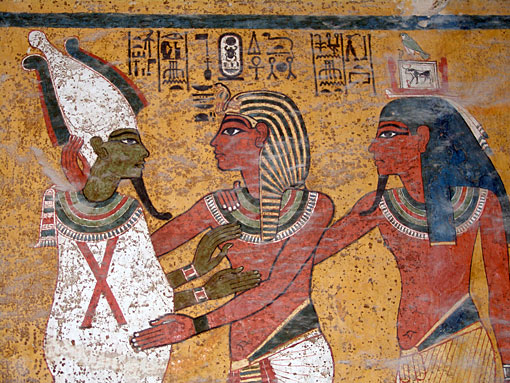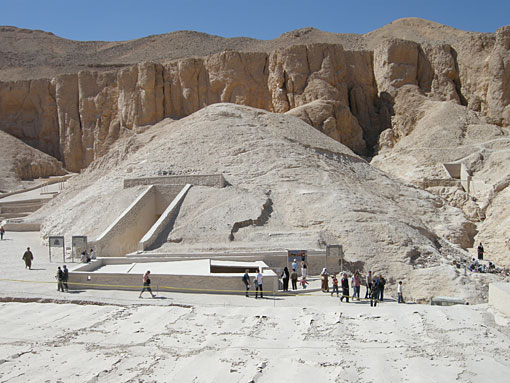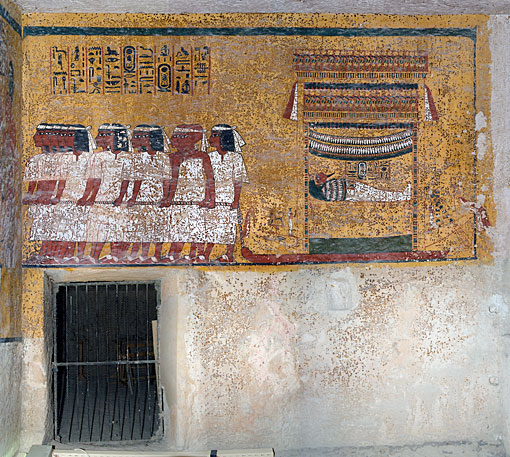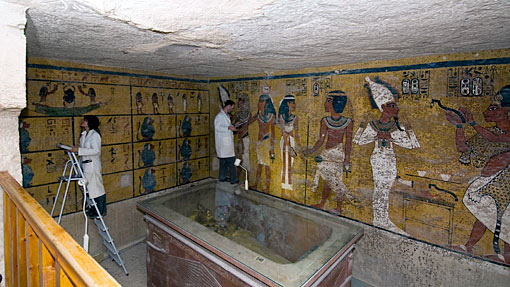| | Fotos de |
Creta
Proyecto de restauración Tumba Tutankhamon
Queridos todos. Os envío un enlace sobre la restauración que el Instituto Getty de Conservación, está llevando a cabo en la tumba de Tutankhamon: http://www.getty.edu/conservation/field_projects/tut/ (En inglés)
Un abrazo
Mummy M.
| Conservation Institute Home The Getty Conservation Institute has entered into a five-year partnership with Egypt's Supreme Council of Antiquities (SCA) to collaborate on a project for the conservation and management of the tomb of Tutankhamen (KV62). Located in the Valley of the Kings, within the World Heritage Site of Ancient Thebes with its Necropolis, the tomb of Tutankhamen is perhaps the most famous of Egypt's pharaonic tombs. In November 1922, when British archaeologist Howard Carter discovered the treasure-filled tomb, the short-lived eighteenth-dynasty pharaoh attained instant and lasting fame. Though KV62 is the smallest of the royal tombs in the Valley of the Kings, it was found with its spectacular funerary contents virtually intact and was scientifically excavated over a ten-year period, thus it is of great historic and cultural value.  Conservation and Management of the Tomb of Tutankhamen Detail of painting on the north wall of Tutankhamen's burial chamber showing Osiris, lord of the underworld, embracing Tutankhamen, who is followed by his ka or spirit twin. Photo: Lori Wong Conservation and Management of the Tomb of Tutankhamen View of the entrance to Tutankhamen's tomb (KV62) in the foreground, with the entrance to the tomb of Rameses VI (KV9) in the mound behind. Photo: Stephen Rickerby | |
 |
Typically, the walls and ceilings of Egyptian royal tombs are decorated with entire texts of the Book of the Dead. By comparison, Tutankhamen's tomb is relatively simple and only the four walls of its burial chamber are decorated. The paintings, as well as some of the tomb's other surfaces, are marred by disfiguring brown spots, the nature and origin of which have never been fully ascertained, though they were noted by the excavation team in 1923. KV62 is one of the most heavily visited sites in the Theban necropolis and the large numbers of visitors may be contributing to the tomb's physical deterioration. The Tutankhamen project will undertake detailed planning for the conservation and management of the tomb and its wall paintings, with the GCI and SCA working jointly to design and implement the plan.
Project Objectives
The objectives of the project are to:
- Establish an accurate record of the present condition of the tomb of Tutankhamen and its wall paintings
- Establish the causes of deterioration of the wall paintings, including the causes and nature of the brown spots, through a comprehensive program of analysis of materials, environmental factors, and condition records
- Assess the physical and environmental impact of visitors on the preservation of KV62 and establish safe visitation parameters
- Design and implement a conservation program for the tomb and its wall paintings
- Improve techniques and materials for conservation of wall paintings
- Enhance the interpretation and presentation of the tomb and its contents, including Tutankhamen's mummy
- Provide training opportunities for SCA staff in all aspects of the project, from planning through treatment of the wall paintings
- Create a long-term monitoring and maintenance program for KV62 and its wall paintings
- Disseminate the results of the work and the information resulting from it
 | |
The project follows a values-based conservation methodology where the historic and artistic values and significance of the tomb guide future conservation and management decisions. The project is divided into three phases. During the first phase (Component One), work will encompass the preparation of an accurate record of the condition of the tomb and its wall paintings, the analysis and diagnosis of the causes of deterioration of the tomb, and the design, testing, and evaluation of appropriate interventions. The work to be conducted during this phase will require a minimum of two years to complete, after which the SCA and the GCI will study the results of the research and consider options for interventions in relation to future plans for visitation to KV62, as determined by the SCA. An agreement between the two organizations regarding a proposed conservation plan will conclude this phase and establish the basis for the next phase.
The second and third phases will be conducted simultaneously over a three-year period. The second phase (Component Two) will focus on the implementation of the conservation plan for the tomb and its wall paintings, and on documentation of treatment carried out. The program for long-term monitoring of the condition and maintenance of KV62, as well as policies for presentation and interpretation, visitation, and other uses of the tomb, will be put into practice during the third phase (Component Three). In the final phase, the results of the project will be evaluated and disseminated (Component Four). Throughout the course of the project, SCA conservators and staff will undergo training in conservation,science and site management. Ultimately, the Tutankhamen project will provide a model case study for the practice of conservation on the West Bank to enhance conservation practice and knowledge regionally.
The Tomb of Tutankhamen Project is the GCI's most recent collaborative project with Egypt. Twenty years ago, institute staff worked with Egyptian colleagues and an international conservation team on the conservation of the wall paintings in the tomb of Queen Nefertari, the queen of the powerful ruler Ramses II. Other GCI collaborative work with Egyptian authorities has included the development of oxygen-free, anoxic display and storage cases for the Royal Mummies in the Egyptian Museum in Cairo, and an environmental monitoring study of the Great Sphinx at the Giza Plateau outside Cairo. Currently, the GCI is also collaborating with the SCA on the development and implementation of a conservation and management plan for the Valley of the Queens.
Last updated: November 2009
##########################################
RSS Feed de Amigos de la Egiptología
http://www.egiptologia.com/index.php?format=feed&TYPE=rss
##########################################
Foro de Discusión sobre el Antiguo Egipto
http://www.egiptologia.com/foro
Recomendamos: Proyecto Dinástico
http://www.tierradefaraones.com
--------------------------------------------------------------
LISTA DE DISTRIBUCIÓN DE AMIGOS DE LA EGIPTOLOGÍA - AE
Gestión Altas-Bajas y consulta mensajes enviados:
http://www.egiptologia.com/lista-de-distribucion.html
Moderador: Víctor Rivas egiptologia@egiptologia.com
Amigos de la Egiptología: http://www.egiptologia.com
Los mensajes de Amigos de la Egiptología son distribuidos gracias al apoyo y colaboración técnica de RedIRIS Red Académica Española - http://www.rediris.es









No hay comentarios:
Publicar un comentario